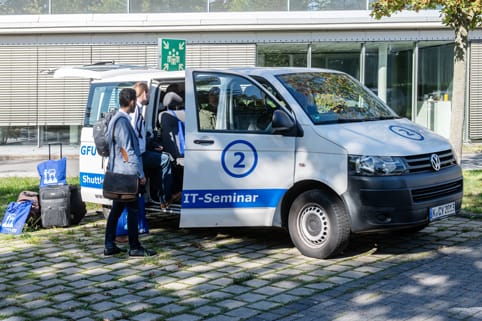Bitte wählen Sie die Bereiche, die Sie exportieren möchten:
Schulungsformen
Offene Schulung
- 3 Tage
- 5 gesicherte Termine
- 1.930,00 p. P. zzgl. MwSt.
- Köln / Online
- Online oder Präsenz
- Dritter Mitarbeitende kostenfrei
Inhouse-/Firmenschulung
- 3 Tage - anpassbar
- Termin nach Wunsch
- Preis nach Angebot
- In Ihrem Hause oder bei der GFU
- Online, Präsenz oder Hybrid
- Lernumgebung in der Cloud
Individualschulung
- 3 Tage - anpassbar
- Termin nach Wunsch
- Preis nach Angebot
- In Ihrem Hause oder bei der GFU
- Online, Präsenz oder Hybrid
- Lernumgebung in der Cloud
Beschreibung
The course then moves on to communication and coordination between microservices, covering both synchronous and asynchronous communication patterns. You'll explore messaging systems, event-driven architecture, and the concepts of service orchestration and choreography.
Another crucial aspect covered in the course is the implementation of API gateways and service discovery. You'll learn about their role, advantages, and how to design and deploy them effectively within a microservices architecture.
The course also focuses on data management in microservices, including topics such as data ownership, database strategies, and the concepts of event sourcing and CQRS (Command Query Responsibility Segregation).
Microservices deployment and monitoring are also covered in detail. You'll explore containerization with Docker, orchestration with Kubernetes, and techniques for monitoring and observability in a microservices environment.
The course includes discussions on best practices and real-world case studies to provide practical insights into microservices architecture. Security considerations, scalability strategies, and key design patterns are also explored.
Schulungsziel
The goal of the Microservices Architecture Basics course is to provide participants with a comprehensive understanding of microservices architecture and its core concepts. By the end of the course, participants will be able to define microservices and explain their benefits. They will learn strategies for breaking down monolithic applications into microservices and understand different communication patterns and coordination mechanisms between services. Participants will also be able to design and implement API gateways and service discovery mechanisms. Additionally, they will gain insights into data management approaches, such as database per service and shared database models, as well as event sourcing and CQRS. The course will cover deployment and monitoring techniques using containerization (Docker) and orchestration (Kubernetes). Participants will learn best practices, design patterns, and security considerations for building scalable and resilient microservices architectures. Real-world case studies will be presented to provide practical examples. Q&A sessions will be conducted to address specific queries and ensure a clear understanding of the course material. Ultimately, the course aims to equip participants with the knowledge and skills necessary to effectively design, implement, and maintain microservices architectures.
Details
Wer teilnehmen sollte
The Microservices Architecture Basics course is designed for a diverse range of participants in the software development and architecture fields. It is suitable for software developers looking to understand and implement microservices architecture, system architects involved in designing scalable and distributed systems, technical leads and engineering managers making decisions about adopting microservices, IT professionals and software engineers seeking to expand their knowledge in architectural paradigms, project managers interested in understanding the benefits and challenges of microservices, software consultants and freelancers offering expertise in microservices architecture, and individuals who want to stay informed about modern software development practices and industry trends. The course caters to both technical and non-technical individuals by providing a comprehensive introduction to microservices architecture and covering foundational concepts and practical implementation considerations.
Ihre Schulung
Präsenz-Schulung | Online-Schulung |
|---|---|
| Lernmethode | |
Ausgewogene Mischung aus Theorie und Praxis | Wie auch bei unseren Präsenz-Seminaren: Ausgewogene Mischung aus Theorie und praktischen Übungen. Trainer durchgehend präsent. |
| Unterlagen | |
Seminarunterlagen oder Fachbuch zum Seminar inklusive, das man nach Rücksprache mit dem Trainer individuell auswählen kann. | Seminarunterlagen oder Fachbuch inklusive (per Post). Das Fachbuch wählt der Trainer passend zum Seminar aus - Ihren individuellen Buch-Wunsch berücksichtigen wir auf Nachfrage gerne. |
| Arbeitsplatz | |
| PC/VMs für jeden Teilnehmenden Hochwertige und performante Hardware Große, höhenverstellbare Bildschirme Zugang zu Ihrem Firmennetz erlaubt |
|
| Lernumgebung | |
| |
| Arbeitsmaterialien | |
DIN A4 Block, Notizblock, Kugelschreiber, USB-Stick, Textmarker, Post-its | |
| Teilnahmezertifikat | |
Die Teilnahmezertifikat inkl. Inhaltsverzeichnis wird Ihnen am Ende des Seminars ausgehändigt. | Die Teilnahmezertifikat inkl. Inhaltsverzeichnis wird Ihnen per Post zugesandt. |
Organisation
Präsenz-Schulung | Online-Schulung | |
|---|---|---|
| Teilnehmendenzahl | ||
min. 1, max. 8 Personen | ||
| Garantierte Durchführung | ||
Ab 1 Teilnehmenden* | ||
| Schulungszeiten | ||
| ||
| Ort der Schulung | ||
 GFU Schulungszentrum GFU SchulungszentrumAm Grauen Stein 27 51105 Köln-Deutz oder online im Virtual Classroom oder europaweit bei Ihnen als Inhouse-Schulung Um ein optimales Raumklima zu gewährleisten, haben wir das Schulungszentrum mit 17 hochmodernen Trotec TAC V+ Luftreinigern ausgestattet. Diese innovative Filtertechnologie (H14 zertifiziert nach DIN EN1822) sorgt dafür, dass die Raumluft mehrfach pro Stunde umgewälzt wird und Schadstoffe zu 99.995% im HEPA-Filter abgeschieden und infektiöse Aerosole abgetötet werden. Zusätzlich sind alle Räume mit CO2-Ampeln ausgestattet, um jederzeit eine hervorragende Luftqualität sicherzustellen. | ||
| Räumlichkeiten | ||
Helle und modern ausgestattete Räume mit perfekter Infrastruktur | Bequem aus dem Homeoffice von überall | |
| Preisvorteil | ||
Dritter Mitarbeitende nimmt kostenfrei teil. Eventuell anfallende Prüfungskosten für den dritten Teilnehmenden werden zusätzlich berechnet. Hinweis: Um den Erfolg der Schulung zu gewährleisten, sollte auch der dritte Teilnehmende die erwarteten Vorkenntnisse mitbringen. | ||
| All-Inclusive | ||
Gebäck, Snacks und Getränke ganztägig, Mittagessen im eigenen Restaurant, täglich 6 Menüs, auch vegetarisch | Eine Auswahl unserer Frühstücks-Snacks und Nervennahrungs-Highlights senden wir Ihnen mit den Seminarunterlagen per Post zu. | |
| Barrierefreiheit | ||
Das GFU-Schulungszentrum (Am Grauen Stein 27) ist barrierefrei | - | |
Buchen ohne Risiko
| Rechnungsstellung |
Erst nach dem erfolgreichen Seminar. Keine Vorkasse. |
| Stornierung |
Kostenfrei bis zum Vortag des Seminars |
| Vormerken statt buchen |
Sichern Sie sich unverbindlich Ihren Seminarplatz schon vor der Buchung - auch wenn Sie selbst nicht berechtigt sind zu buchen |
Kostenfreie Services
Präsenz-Schulung | Online-Schulung |
|---|---|
|
|
Inhalt
- Definition and characteristics of microservices
- Modular and loosely coupled components
- Independent deployment and scalability
- Technology heterogeneity
- Advantages and challenges of microservices architecture
- Improved agility and scalability
- Increased fault isolation and resilience
- Complexity of distributed systems and inter-service communication
- Comparison with monolithic architecture
- Contrasting architecture styles and trade-offs
- Considerations for migration and adoption
- Use cases and scenarios for microservices
- Industries and domains benefiting from microservices
- Examples of successful microservices implementations
- Identifying bounded contexts and business capabilities
- Analyzing business domains and boundaries
- Identifying cohesive and loosely coupled components
- Domain-driven design principles and concepts
- Ubiquitous language and bounded contexts
- Aggregates, entities, and value objects
- Context mapping and subdomains
- Strategies for breaking down monolithic applications into microservices
- Strangler pattern and incremental migration
- Vertical and horizontal decomposition approaches
- Extracting microservices based on bounded contexts
- Dependency management and modularization
- Managing inter-service dependencies
- Defining service interfaces and contracts
- Techniques for service decoupling
- Synchronous vs. asynchronous communication patterns
- RESTful APIs and HTTP-based communication
- Messaging systems and event-driven architecture
- Message-oriented middleware and event-driven architecture
- Pub/sub and message queues
- Event sourcing and event-driven workflows
- Implementing messaging systems
- Evaluating messaging technologies (e.g., RabbitMQ, Apache Kafka)
- Integrating messaging patterns into microservices
- Service orchestration vs. choreography
- Centralized orchestration and workflow engines
- Decentralized choreography and event-driven collaboration
- Role and benefits of an API gateway
- Aggregating and routing requests
- Authentication and authorization enforcement
- Caching and rate limiting
- Designing and implementing an API gateway
- API gateway patterns (e.g., reverse proxy, facade)
- Securing API gateway endpoints
- Logging and monitoring API traffic
- Service discovery and registration mechanisms
- Service registry and discovery patterns (e.g., Consul, Eureka)
- Dynamic service registration and health checks
- Load balancing and routing strategies
- Data ownership and consistency in microservices
- Strategies for managing data per microservice
- Maintaining consistency in distributed transactions
- Database per service vs. shared database approaches
- Pros and cons of each approach
- Polyglot persistence and choosing the right database
- Event sourcing and CQRS
- Capturing and storing events for audit and replay
- Separating read and write models
- Data integration and synchronization techniques
- Data replication and eventual consistency
- API versioning and data transformation
- Containerization with Docker
- Docker basics and container orchestration
- Packaging microservices into containers
- Orchestration with Kubernetes
- Deploying and managing microservices in Kubernetes
- Scaling and load balancing with Kubernetes
- Continuous Integration and Deployment (CI/CD) pipelines
- Setting up CI/CD pipelines for microservices
- Automated testing and deployment strategies
- Monitoring and observability in a microservices environment
- Logging, metrics, and tracing for microservices
- Implementing centralized logging and log aggregation
- Collecting and analyzing metrics for performance monitoring
- Distributed tracing for request tracking and troubleshooting
- Design patterns for microservices
- Circuit Breaker pattern for fault tolerance
- Saga pattern for distributed transactions
- API Gateway pattern for centralized API management
- Security considerations in microservices architecture
- Authentication and authorization strategies
- Role-based access control (RBAC) and OAuth
- Securing inter-service communication
- Scalability, resilience, and fault tolerance strategies
- Horizontal scaling and load balancing
- Resilience patterns (retry, timeout, fallback)
- Handling failures and fault isolation
- Real-world case studies and lessons learned
- Case studies of successful microservices implementations
- Challenges faced and strategies for overcoming them
- Best practices and key takeaways from real-world experiences
Buchungsmöglichkeiten
Online oder in Präsenz teilnehmen
Sie können sowohl Online als auch in Präsenz am Seminar teilnehmen. Klicken Sie bei Ihrer Buchung oder Anfrage einfach die entsprechende Option an.
Gesicherte offene Termine
| Termin | Ort | Preis | |
|---|---|---|---|
| 20.01.-22.01.2025 Plätze vorhanden Köln / Online 1.930,00 | Köln / Online | 1.930,00 | Buchen Vormerken |
| 23.04.-25.04.2025 Plätze vorhanden Köln / Online 1.930,00 | Köln / Online | 1.930,00 | Buchen Vormerken |
| 21.07.-23.07.2025 Plätze vorhanden Köln / Online 1.930,00 | Köln / Online | 1.930,00 | Buchen Vormerken |
| 20.10.-22.10.2025 Plätze vorhanden Köln / Online 1.930,00 | Köln / Online | 1.930,00 | Buchen Vormerken |
Inhalte werden auf Wunsch an die Anforderungen Ihres Teams angepasst.
- Online, Präsenz oder Hybrid
- Komplette Lernumgebung in der Cloud mit Remote Zugriff
Fokus aufs Fachliche und maximaler Raum für individuelle Fragen.
- Online, Präsenz oder Hybrid
- Komplette Lernumgebung in der Cloud mit Remote Zugriff
Unterstützung nach der Schulung durch
individuelle Nachbetreuung
- Alle folgenden Schulungsformen können auch Online als Virtual Classroom durchgeführt werden.
- Eine Offene Schulung findet zu einem festgelegten Zeitpunkt im voll ausgestatteten Schulungszentrum oder Online/Remote statt. Sie treffen auf Teilnehmende anderer Unternehmen und profitieren vom direkten Wissensaustausch.
- Eine Inhouse-/Firmen-Schulung geht auf die individuellen Bedürfnisse Ihres Unternehmens ein. Sie erhalten eine kostenfreie Beratung von Ihrem Seminarleiter und können Inhalte und Dauer auf Ihren Schulungsbedarf anpassen. Inhouse-Schulungen können Europaweit durchgeführt werden.
- Bei einer Individual-Schulung erhalten Sie eine 1-zu-1 Betreuung und bestimmen Inhalt, Zeit und Lerntempo. Der Dozent passt sich Ihren Wünschen und Bedürfnissen an.
Sie können unsere Schulungen auch als Remote Schulung im Virtual Classroom anfragen.
In drei Schritten zum Online Seminar im Virtual Classroom:
- Seminar auswählen und auf "Buchen" klicken
- Wählen Sie bei "Wie möchten Sie teilnehmen?" einfach "Online" aus.
- Formular ausfüllen und über den Button "Jetzt buchen" absenden.
Unser Kundenservice meldet sich bei Ihnen mit der Buchungsbestätigung.
Unsere Online Schulungen finden im Virtual Classroom statt. Ein Virtual Classroom bündelt mehrere Werkzeuge, wie Audio-Konferenz, Text-Chat, Interaktives Whiteboard, oder Application Sharing.
Vorteile von Virtual Classroom:
- Sie erhalten 1 zu 1 die gleiche Lernumgebung, die Sie auch vor Ort bei uns vorfinden
- Die technische Vorbereitung wird von den GFU-Technikern vorgenommen
- Sie erhalten remote Zugriff auf Ihren persönlichen Schulungs-PC im GFU-Seminarraum
- Die Virtual Classroom Lösung lässt sich auch im Browser betreiben
- Die GFU-Technik leistet wie gewohnt Soforthilfe bei Problemen
- Die Schulungsunterlagen bekommen Sie per Post zugeschickt
- Sie sparen Reisekosten und Zeit
- 20. Jan. - 22. Jan. ✓ Noch einige Plätze frei ▶ Köln + Online/Remote
- 23. Apr. - 25. Apr. ✓ Noch einige Plätze frei ▶ Köln + Online/Remote
- 21. Jul. - 23. Jul. ✓ Noch einige Plätze frei ▶ Köln + Online/Remote
- 20. Okt. - 22. Okt. ✓ Noch einige Plätze frei ▶ Köln + Online/Remote
- Auch als Inhouse-Schulung, bundesweit mit Termin nach Wunsch und individuellen Inhalten
- Buchen ohne Risiko! Kostenfreie Stornierung bis zum Vortag des Seminars
Buchen Sie diese kostenfreien Serviceleistungen für Präsenzseminare ganz einfach während des Buchungsprozesses dazu!

Machen Sie sich keinen Kopf um die Anreise! Unser Shuttle fährt Sie. Oder Sie parken einfach auf einem extra für Sie reservierten Parkplatz.

Hotelzimmer gesucht? Wir organisieren Ihnen eins. Ihr Vorteil: Sie sparen Zeit und Geld!

Gesund oder lecker? Warum nicht beides? Freuen Sie sich auf unsere kulinarische Verpflegung!

Parkplätze sind in ausreichender Zahl vorhanden. Reisen Sie mit dem Auto an, reservieren wir Ihnen einen Parkplatz.